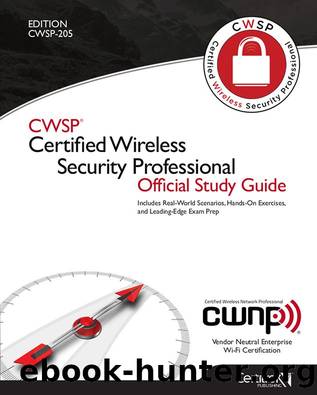CWSP® Certified Wireless Security Professional Official Study Guide by Tom Carpenter

Author:Tom Carpenter
Language: eng
Format: epub
Publisher: Certitrek Publishing
Published: 2015-03-15T00:00:00+00:00
Chapter Summary
In this chapter, you learned about the importance of authentication and the different authentication methods available in 802.11 WLANs. You explored the 802.1X/EAP enterprise authentication solutions and the different EAP types. This information will be essential for the CWSP exam, but it is also important to know so that you can make effective decisions when designing security in the real world.
Facts to Remember
Be sure to remember the following facts as you prepare for the CWSP certification and be sure that you can explain the details related to them:
Authentication is used to validate credentials and is the foundation of all other security technologies.
Passphrase security, or a preshared key (PSK), is useful in SOHO and small business deployments with a few dozen clients.
When using a PSK, the password used to generate the PSK should be random and difficult to guess. It should also be very long.
WPA- and WPA2-Personal use a PSK implementation.
WPA- and WPA2-Enterprise us an 802.1X/EAP implementation.
WPA supports TKIP/RC4 and WPA2 supports CCMP/AES.
You can identify the PSK authentication when the AKM Suite type is equal to 00-0F-AC:02.
Triple-A (AAA), as a security principle, consists of authentication, authorization and accounting.
Mutual authentication means that both the authentication server and the client are authenticated.
RBAC (Role-Based Access Control) is a method used to provide authorization through groups or roles.
RBAC typically involves the creation of policies and the assigning of these policies to groups or roles.
Accounting can be provided through RADIUS servers and Syslog servers.
802.1X provides port-based authentication.
Extensible Authentication Protocol (EAP) is a framework on which different types of EAP authentication methods are build, such as EAP-TLS and PEAP.
EAP-MD5 and LEAP should not be used.
PEAP, EAP-TLS, EAP-TTLS and EAP-FAST can all be implemented in a secure manner.
Lightweight Directory Access Protocol (LDAP) servers are often used to provide a credential store for 802.1X/EAP authentication through RADIUS servers.
Download
This site does not store any files on its server. We only index and link to content provided by other sites. Please contact the content providers to delete copyright contents if any and email us, we'll remove relevant links or contents immediately.
TCP IP by Todd Lammle(2640)
MCSA Windows Server 2016 Study Guide: Exam 70-740 by William Panek(2313)
The KCNA Book by Nigel Poulton(1973)
Red Hat Certified Specialist in Services Management and Automation EX358 Exam Guide by Eric McLeroy(1951)
Networking A Beginner's Guide by Bruce Hallberg(1933)
31 Days Before Your CompTIA A+ Exams (Shanette Luellen's Library) by Benjamin Patrick Conry(1665)
Unity Certified Programmer: Exam Guide by Philip Walker(1490)
MCSA Windows Server 2016 Study Guide: Exam 70-741 by William Panek(1479)
PHP 7 Zend Certification Study Guide by Andrew Beak(1453)
Healthcare Information Security and Privacy (All-In-One) by Sean Murphy(1370)
CompTIA A+ Certification Guide (220-901 and 220-902) by Matthew Bennett(1338)
Microsoft Security, Compliance, and Identity Fundamentals Exam Ref SC-900 by Dwayne Natwick(1306)
RHCSA & RHCE Red Hat Enterprise Linux 7: Training and Exam Preparation Guide (EX200 and EX300), Third Edition by Asghar Ghori(1303)
Designing and Implementing Microsoft Azure Networking Solutions by David Okeyode(1298)
Essential Office 2016 by Wilson Kevin(1254)
Mobile Computing Deployment and Management by Robert J. Bartz(1254)
Essential Office 2016 (Computer Essentials) by Kevin Wilson(1227)
The Tao of Network Security Monitoring by Richard Bejtlich(1195)
CCNA Cisco Certified Network Associate Practice Labs and Simulations by Shwergho Smith(1149)
